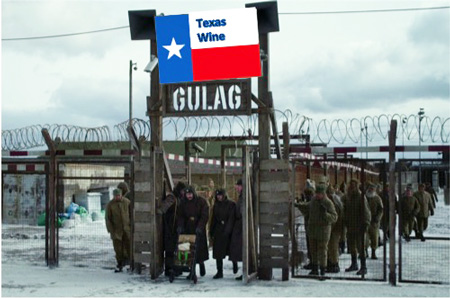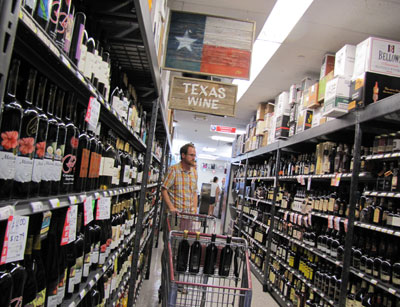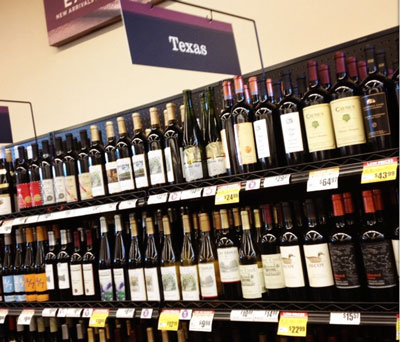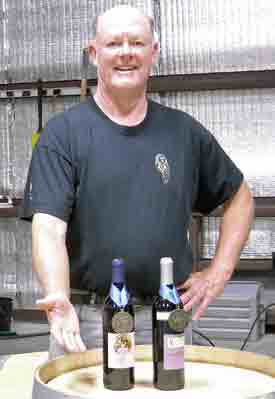
The Texas Wine Gulag
How Big Retail Is Wrecking The Texas Wine Business
VT Guest Blog by: R.L. Winters (Master Horticulturist/Ampelographer Fairhaven American Hybrid Research Foundation), Owner & Winemaker Fairhaven Vineyards
— — — — —
How many times have you gone into a liquor retailer looking for a specific wine and been told: “Oh, the reason you can’t find it is because the Texas wines are ‘Over There’. Have you noticed, that frequently, ‘Over There’ really means ‘Back There’.
I have begun to question the reasoning behind store schematics that take a specific regional wine and (effectively) locks it up, prisoner, to a separate, and frequently, remote section of the retail area. In Texas, this is effectively ‘The Texas Wine. Gulag’.
Does this ‘Texas Wine Section’ really stimulate sales, or does it guarantee that the majority of wine shoppers won’t see your product?
One recent experience I’ve had with one of the large Texas retailers points up the problems that Texas wineries face in the crowded wine market.
I’ve had not less than a dozen phone conversations with the wine buyer and, amidst all of the label grumbling (click here for more on label grumbling), I was presented with a long list of excuses why the buyer simply doesn’t have the time to sample my products.

Assuming I (or you if presented with the same situation) have the patience and perseverance at a level granted to few mortals, I might end up with five minutes with the retailer to offer up my wines!
In this case, two months later, there we were, working our way thru the maze of the Mega store on the outskirts of Houston. In the treasures I was carrying was a Double Gold Medal Merlot Blend, a World Bronze Medal Texas Heritage Wine, a World Bronze Medal Chambourcin, and two delicious semi-sweet French American Hybrid Wines. Wow! Looks like a slamdunk doesn’t it! Finally, the buyer agreed to sell three of the wines, the ones I took a cut of nearly two dollars a bottle on, and the more complex and interesting wines were rejected.
I was then treated to a tour of the “Texas Wine Section”. And, where was this section? ALL THE WAY AT THE BACK OF THE STORE… with cheap liquor on one side and jug wines on the other. The perfect Gulag for my (or your) wines!
The guided tour was a revealing experience that included addle minded comments from the buyer like:
“Why don’t you take a red wine and blend it with a white wine and produce something that would be priced around $9 a bottle?”
So, it really didn’t matter what it was, after all, just so it was around nine dollars a bottle! Nor did it matter how creative your wines were, or how good of a job they did representing the varietals from which they were made. It somehow had to do with the fact that they were “Texas Wines” and therefore (or so the reasoning goes) are somehow fundamentally inferior. You could safely assume that the retail buyer had never suggested to the California producers that they rush back to their blending bench and whip something up for the ‘misery market’ [or relegate their wine the back-of-House Gulag].
I say, if there’s a Texas Cabernet that is on equal footing with, say, some of the better Napa wines, then why not let the Texas wine compete on equal footing? Many retailers are moving away from the “Texas Section” concept to simply grouping wines by varietal types. Promoting Texas wines even in this schematic is easily accomplished by identifying the varietal (or blend) as a Texas product. Simple huh.

But then there’s that troubling thought that looms over this issue… Many retailers use the Texas Section (the Gulag) as a tool to push the smaller wineries into disastrous price concessions and a product placement that leads to poor turnover, that, in turn, leads to yet another round of price cutting.
The intent of modern Texas winery laws was to return Texas to its rightful place in wine history. But, it’s as if the Legislature enacted a carefully crafted law, but forgot that greed and avarice on the part of Big Retail and the Distribution Tier of the business would spend ALL of their spare time trying to figure out how to undermine a well thought out piece of legislation.
A more enlightened approach would be to enact legislation requiring retailers to carry a minimum percentage of Self-Distributed local wines in return for a reduced sales tax on sales. This method would end up a zero sum game, because the increase revenue from the sales of Texas wines would offset the amount of sales tax relief to the retailer and the associated business generated by the Texas wineries.
Texas wineries are constantly bedeviled by a host of regulatory problems that range from onerous reporting rules that, rightfully, are the responsibility of other agencies (e.g. outside sales reporting), mountains of ridiculous, antiquated, rules that limit their ability to serve their products to the public, and an (apparently) endless line of agencies (replete with some real zealots) that seem to attempt to justify their existence by creating more paper work.
If the State of Texas is serious about building the Texas wine industry as an important component of the Texas economy, then it’s time to act to create an environment where the opportunity to grow is assured for all of wineries, not just a few. The issue of aiding the Texas wineries, in an effort to gain more access to the market, is definitely within reach.

From the Texas Wine Gulag, by R.L. Winters, Fairhaven Vineyards. Click here to read the complete unedited version of R.L. Winter’s “The Texas Wine Gulag”.

Can’t believe I’m about to say this because I too was dissed by this particular retailer (and we all know the name of the Houston based mega retailer you’re talking about), but I’m on the side of the retailer and take issue with your statement that big retail is wrecking Texas wine.
I own and operate a hill country winery and had my wines in this chain’s stores for a number of years before they decided I was a pain in the ass and had to go. We went through the same asking for deep discounts BS that you went through, we declined, and were shown the door. When we started dealing with these people our contact was a real wine guy who valued quality and uniqueness and was willing to stock a few brands that may not just fly out the door like Kendall Jackson and its ilk. Then he was replaced by a numbers guy who cared nothing about tasting the wine, only how much it cost and how deep we were willing to discount.
My defense of the retailer rests on one simple point. Their job is to make money. They put up the capital to buy real estate, stock inventory and invest in people who could maximize their return on investment. That’s their job, they invest to get a decent return, not to satisfy the whim of the occasional customer who wants your wine or mine.
You, on the other hand, have also invested in property, equipment and inventory and need to also earn a return. That might best be done by maximizing traffic to your tasting room, selling to smaller stand alone retailers who appreciate your product for what it is, or calling on enough restaurants to move significant quantities of wine (tough job). Point is, it’s your job to make that happen and not whine about the mega retailer that may think a Texas Chambourcin is going to sit on the shelf for a while, which it probably is.
Take home message is that the world is full of ass holes and some of them make wine buying decisions. My advice is to get on down the road, sell your product to those who appreciate it, and don’t do business with people you don’t like.
@alamosawineguy
You make several valid points but I think you missed main issue. And that is how product placement affects price structure. The practice of engineering lousy placement, and then using that as a tool to undermine pricing has become rampant. The practice has a detrimental effect on ALL Texas wines, not just the price, but how they are perceived. A personal decision to not vend through the retail process won’t protect your products from collateral damage!
Oh, and BTW you should come up to speed on the development of the French American Hybrids in Texas. There are some stunning, super high quality wines being produced from them now, especially in the upland alluvial soil types. We would happy to send one such!